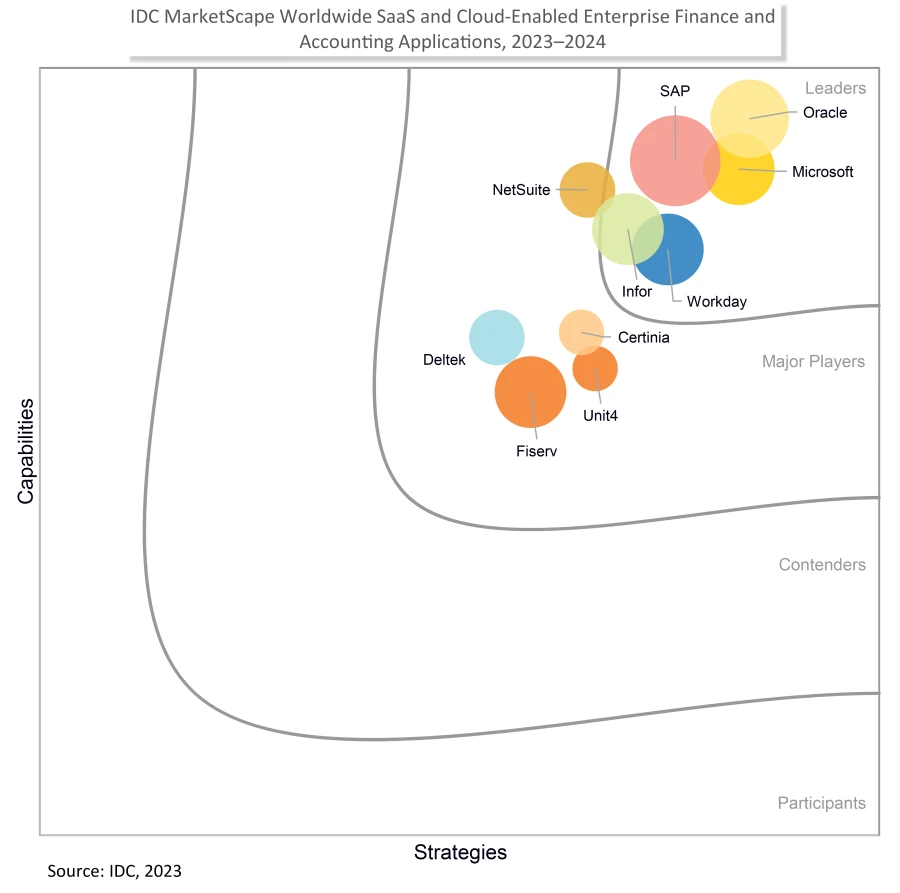
Microsoft named as a worldwide Leader in IDC MarketScape for Finance and Accounting Applications for Enterprise, Midmarket, and Small Business
This article is contributed. See the original author and article here.
To thrive in today’s highly complex global business environment, organizations are increasingly relying upon the technological and strategic prowess of their financial leaders. We’re continually investing in Microsoft Dynamics 365 to enable finance leaders to monitor financial operations in real time, predict outcomes, and drive strategic decision-making that hinges on insight.
We are pleased to announce that Microsoft has been recognized as a Leader in three IDC MarketScape reports—IDC MarketScape: Worldwide SaaS and Cloud-Enabled Enterprise Finance and Accounting Applications 2023-2024 Vendor Assessment (doc #US51405823, December 2023); IDC MarketScape: Worldwide SaaS and Cloud-Enabled Midmarket Finance and Accounting Applications 2023-2024 Vendor Assessment (doc #US51405023, December 2023); and IDC MarketScape: Worldwide SaaS and Cloud-Enabled Small Business Finance and Accounting Applications 2023-2024 Vendor Assessment (doc #US48041222, December 2023).

Read the IDC excerpt
Dive deeper into the IDC MarketScape for Worldwide SaaS and Cloud-Enabled Enterprise Finance and Accounting Applications excerpt.
According to the IDC MarketScape for Enterprise Finance and Accounting Applications, “Consider Microsoft when you are searching for a well-established provider with the resources to innovate quickly and effectively.”

Boost productivity with Copilot for Dynamics 365
As the pace of business accelerates, the role of finance leaders has shifted. They are called to navigate a range of new challenges and responsibilities: reporting on the past, managing the present, and creating the future.
Today, financial leaders are responsible for much more than finance, as they are increasingly accountable for the strategic direction of the company. The scale and pace of decision-making has increased compared to the previous generation, which was called on to help make quarterly decisions. Now, finance leaders make critical financial decisions weekly—and in some cases, daily.
According to the IDC MarketScape for Enterprise Finance and Accounting Applications, “We will see the demand for more analytics, reporting, and data visualization tools. This trend will continue to accelerate and shape buying decisions for financial leaders.”
Our answer to this is to provide simple solutions—focusing on collaboration, productivity, AI, and insights—to help finance leaders make data-driven decisions and drive business agility and growth. According to the IDC MarketScape for Enterprise Finance and Accounting Applications, “Microsoft Dynamics 365 Copilot brings together Azure OpenAI and ChatGPT. Copilot is embedded in Dynamics 365, working alongside business professionals to help them create ideas and content faster, complete time-consuming tasks, and get insights and next best actions. This enables users of all technical abilities to use AI to boost their productivity and focus on more important tasks.” A great example of this is HB Antwerp, a Belgian company redefining how natural diamonds are sourced, crafted, and sold.
In 2024, the company plans to up the value of diamonds tracked to USD 1 billion. In terms of continuing to use AI like Copilot, it said that 60% of emails are written with AI, suggesting the importance of AI to the future of the company. This enables users of all technical abilities to use AI to boost their productivity and focus on more important tasks.
“There’s an unprecedented level of maturity, collaboration, and relationship to new products like Copilot, which are crucial to growth.”
Shai de-Toledo: Co-founder & Managing Partner, HB Antwerp
Optimize your operational workflow within Microsoft Power Automate
The IDC MarketScape for Enterprise Finance and Accounting Applications also noted, that, “These process mining capabilities simplify how work gets done by discovering workflow bottlenecks and further automation opportunities.” This is something that Microsoft customer, HB Antwerp, experienced firsthand. This Belgian diamond company set out to challenge the age-old opacity of the industry.
HB Antwerp turned to Microsoft and its Microsoft Dynamics 365 Finance, Microsoft Dynamics 365 Project Operations, and Microsoft Power Apps, using ledger technologies to record immutable data points across the diamond’s journey, ensuring sustainability and visibility every step of the way. Now HB Antwerp can predict its profit more accurately, reduce errors, increase communication, and ensure maximum value for everyone involved. Miners and governments reap the financial benefits and consumers can see how their diamond purchases contribute to transforming Botswana’s economy and the lives of its citizens.
HB Antwerp has embraced the move from being just a diamond company to a data company.
“It’s about how do you mine data and create scalability on it that attracts different humans, companies, and institutions who want to be a part of the story, and that’s how we aim to grow.”
Shai de-Toledo: Co-founder & Managing Partner, HB Antwerp
From mining stones to mining data, Dynamics 365 embeds automation into the flow of work throughout, enabling business process optimization for business decision makers.
Learn more through the IDC excerpt
Curious to dive deeper? Read the IDC MarketScape for Worldwide SaaS and Cloud-Enabled Enterprise Finance and Accounting Applications excerpt.
Learn more about:
Contact your Microsoft representative to learn more about the value and return on investments, as well as the latest offers—including Dynamics 365 Finance Premium.
Notes:
* The IDC MarketScape vendor analysis model is designed to provide an overview of the competitive fitness of ICT suppliers in a given market. The research methodology utilizes a rigorous scoring methodology based on both qualitative and quantitative criteria that results in a single graphical illustration of each vendor’s position within a given market. The Capabilities score measures vendor product, go-to-market, and business execution in the short-term. The Strategy score measures alignment of vendor strategies with customer requirements in a three to five-year time frame. Vendor market share is represented by the size of the icons.
The post Microsoft named as a worldwide Leader in IDC MarketScape for Finance and Accounting Applications for Enterprise, Midmarket, and Small Business appeared first on Microsoft Dynamics 365 Blog.
Brought to you by Dr. Ware, Microsoft Office 365 Silver Partner, Charleston SC.




Recent Comments